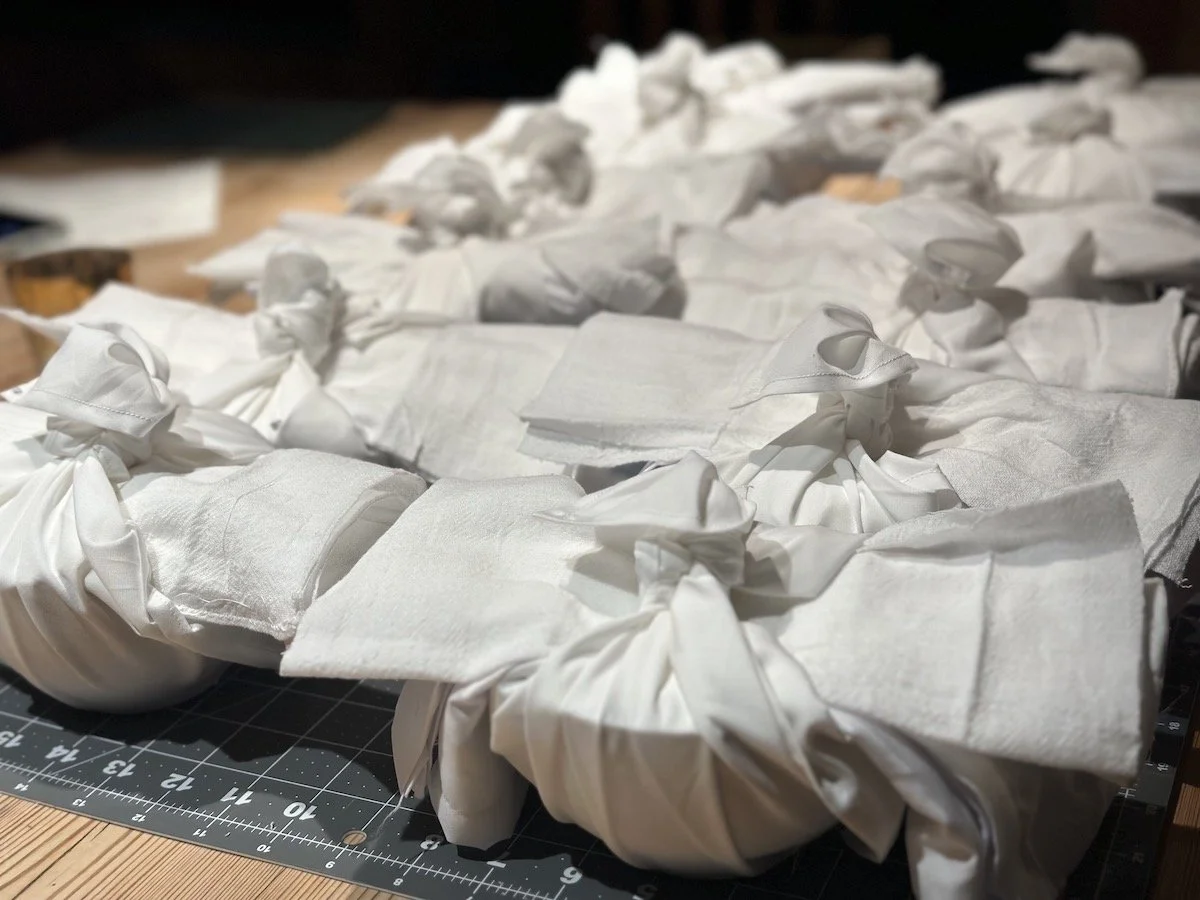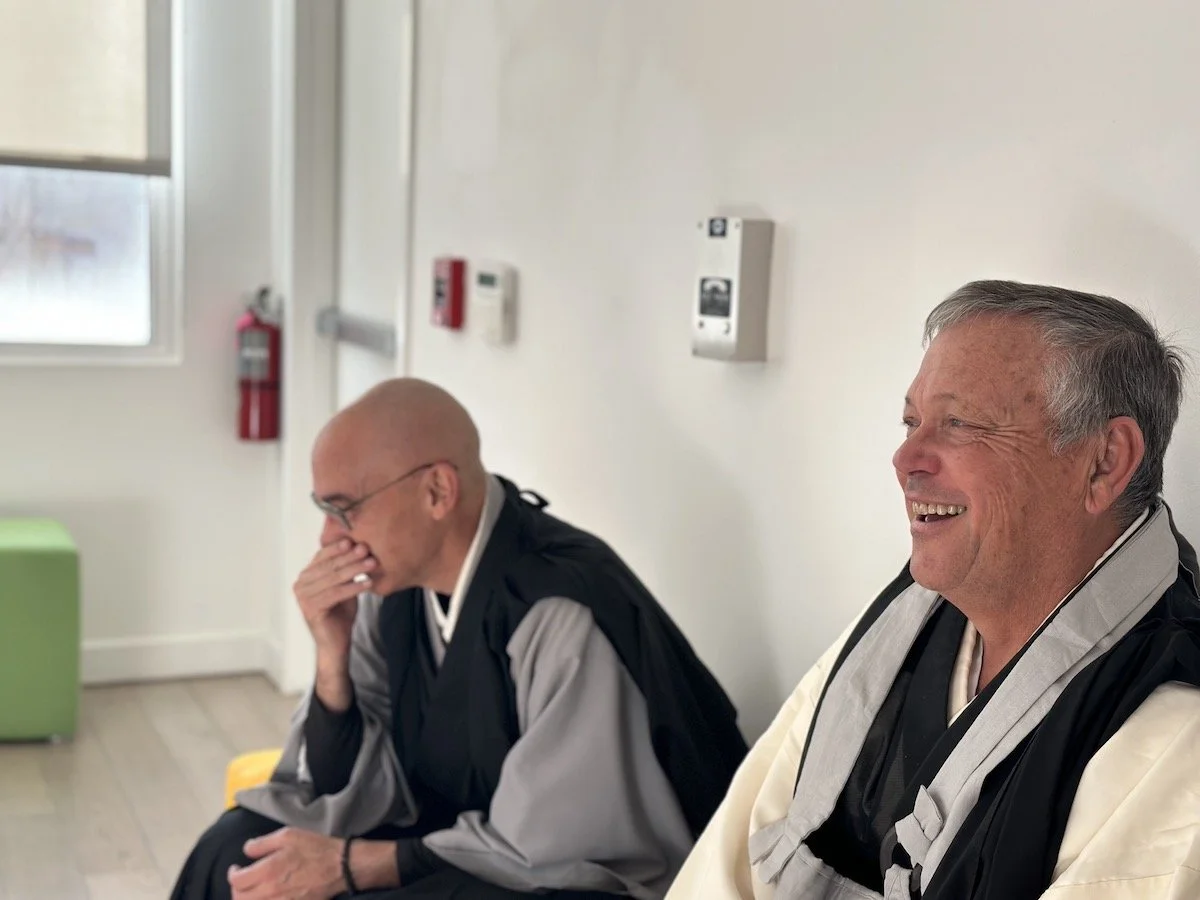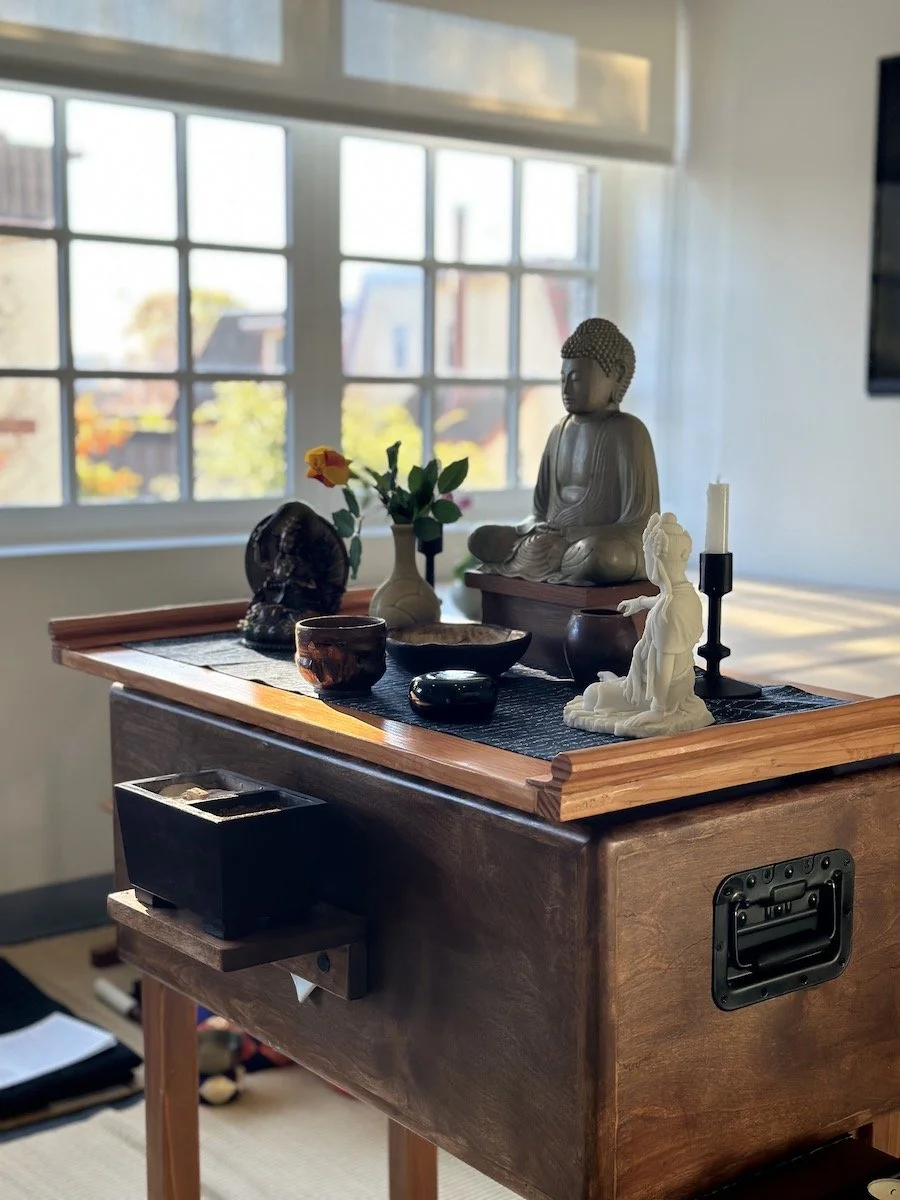A monk asked Zhaozhou to teach him.
Zhaozhou asked, "Have you eaten your meal?”
The monk replied, "Yes, I have."
"Then go wash your bowl", said Zhaozhou.
At that moment, the monk was enlightened.
by Joseph Hall
Strangely, the most common complaint we hear about sesshin has nothing to with knees but the ease at which sesshin mind evaporates when the ignition key is turned. This seems to go along hand and hand with the idea that zen can only be fully practiced at the temple and inspires questions that always arise with a dispiriting sense of sadness. Thus, on the Thursday after Rohatsu this year, I discovered a small but important fact. I could feel the elements of sesshin as I walked around the house. There was a little more stillness in the world as I sat and as I worked. There was a flow from one task to another until the days ended in the refuge of sleep. This would have been unremarkable except I moved down the hill several years ago and quickly learned that it was no easy task to bring sesshin home.
The last time I sat Rohatsu was at one of our local temples, Santa Cruz Zen Center, and it was a beautiful and transformative experience. Patrick and Gene brought forth all the traditional elements solidly and we sat in deep silence until we learned to recognize our new friends by the sound of their footsteps. The whirl of thoughts seemed to lose their weight and drift away, leaving us all floating deep in sesshin mind. After the last bell, I left grateful for the rare gift we had received and moved the car mindfully toward home. And although the distance traveled was a single mile, by the time I walked through the door, I felt ready to take on the long list of work to make up for the time away. There were three jobs that needed updates, a comments list from the city to respond to, of course the house needed attention after the sudden departure and treating it as a bunkhouse for the few hours of sleep we got during sesshin, our neighbor needed help with the internet, and what the heck happened to all that serenity? By Tuesday, my memories of sesshin were neatly filed away in my mind somewhere near various graduation ceremonies, the cities where I used to live, and my parent’s advice when I was young.
So last Thursday, noticing sesshin was still in the room with me, I was, in a very zen way, struck by a simple question: ‘what is this karma happening right now?’ Since I am a zen student and this was a question on the nature of karma (the law of cause and effect), I sat down immediately on the floor of the shower and tried to open my mind until the hot water ran out. I decided two things. First, I needed to make a list for myself (which is presently becoming a blog post) and that it would be OK to shave on Friday. One can’t very well study karma without considering that once the hot water is gone, it will not appear again in this precious shower. In any case, why did rohatsu stay with me this year instead of following the path of the warm water?
My first thought was that it was not the quality of the sesshin. At SCZC Patrick, Gene and the sangha, had built a superb sesshin and had honed it together for many, many years. This year, Pop Up Zendo happened to be the host sangha for the first Rohatsu for Phoenix Heart. While we have been a zendo for a few years now, Rohatsu required a temple, and we had spent the previous three weeks doing woodworking, sewing, planning, finding the right rubber spatulas, and we were operating at full bore. We got the job done, but we arrived at the venue with several carloads of gear and a head full of steam. Since Phoenix Heart is a group of sanghas, people arrived from four different states, most of us shaking off the rain and rushing towards one another in the last steps of many long journeys. We scattered the furniture and spent the next few days refining our little temple and synchronizing our forms. Our first sesshin was a warm and deeply connecting experience, but placing the two sesshins side by side in my memory, it was clear that the root cause was not the development of a perfect Rohatsu. In fact I had spent most of it running around correcting chant cards and trying to find the elements that had been forgotten. In the end, I had missed the extended depths of sesshin as I was constantly crossing back and forth across the threshold to the zendo. So it wasn’t a question of the intensity of my zazen, it was a question of how we made the transitions, not just the zendo door but through the entire journey. Inadvertently, on arriving home, the forms had somehow seeped into the everyday, and found their shape in my daily life.
In a monastery, when we leave sesshin we don’t go far. Sesshin ends with a day off, which, for a monk, is usually a busy morning of hand washing clothes, cleaning the cabin, and maybe reading a book and writing a letter. Sesshin stays with a person living in a monastic world a little longer because we don’t really go home. We are home and by the time the sun rises the next morning, you are already back sitting in the zendo. Intensive sitting comes in waves and each wave comes just as the last recedes and so the phenomenon of a rising tide gradually sways to wash the self away. And while we constantly say that zazen is the answer to everything, it is also said that our true practice is everyday activity. For a monastic, everyday activity has a close relationship to the zendo, since our eating, work, and routine change very little in sesshin, they just get slower and more of our attention.
In the world that we live in, while there is a lot more noise and the occasional slamming of brakes, our everyday activity can seem radically different than how we lived in sesshin, which seemed very clear as I sat on the floor of the shower, noticing that it was the only place where I could rely on ‘silence’ for the rest of the day. But yet there was a clear quality of the feeling that was moving with me: I was intimate with the chores and projects that were making up my days. So it wasn’t my diet or the particular things I was doing that mattered, the key to transforming my karma was an intentional shift of the energy of Rohatsu into what I was doing in this moment.
And while I just said the key was intention, in reality, the circumstances of building a zendo and then tearing it down was more serendipitous then well executed this year. Thus, it seems a good time to write a note to my future self about sesshin.
Dear self, enjoy sesshin, and while there, please feel free to follow instructions and sit deeply in waters of intensive practice. At the conclusion of sesshin, your practice will feel a little more natural and you will see clearly that the sounds of the world move through an ocean of silence. That water is everywhere. If you would like to bring it home with you, the steps below might help make that possible.
Practice Gratitude. Before leaving sesshin, take an emotional risk and thank people for supporting your practice. Gratitude is a cornerstone of sesshin mind and the easiest gate by which to return. We do not get enlightened by ourselves and as we share these small moments of appreciation with each other, we can see the buoyancy that arises in others and that the deep connections that have formed are real.
Drive carefully. When the car starts, habituated busy mind naturally arises, along with our many judgements about the road. Unroll the window and let this go for a little while. Driving itself can be a powerful practice but mostly, we just want to see if we can make it through this segment of our journey without losing it behind the wheel. Very important to enjoy the way the world feels now that it’s been stripped of a whole lot of self.
Wash your Bowls. On arriving home, if you have your own oryoki bowls, wash your bowls and set the linens aside to be washed. Now is a good time to sew a new setsu tip. (If that’s a meaningful sentence to you.) Take gentle care of your bowls and place them on a shelf where you know that they are always ready for sesshin. Launder your sesshin clothes and if you have particular clothing for sesshin, place those items in a place of reverence where they too can help support your practice. For clothing and gear that will be part of your days between intensives, fold and store them carefully, being sure to use some of that gratitude you gained to appreciate the many beings that created them and brought them to you.
Clean the house like you have never been here before. And think about refining things. This is a rare opportunity to transfer the mind state of cleaning the sacred bowls directly to the rest of the kitchen, the cereal bowls, and beyond. If everything has Buddha nature than that means the kitchen is also a dharma gate. You made a shift in sesshin. The world is a little different and you are noticing details that were never before apparent. Looking around, a little disorder has arisen from your sudden departure but returning, we carry new possibilities. One of the habits that seems to arise everywhere in zen, is that priests are always making little adjustments, whether it be the altars, a garden, or the text of chants and schedules. Go with this impulse. Not only does it improve your environment, but it requires that we pay attention and look more deeply. Make a circle around your home in curiosity, noticing the myriad details, and feel free to move the lamp to the center or just a half inch to the left.
Wear some clothes that drape Objects are valuable teachers, primarily because we can’t argue with them. They just are Buddha nature. Robes, for a monastic are basically several yards of fabric functioning randomly as a dead weight, a trip-fall hazard, something to possibly transfer the flame of a candle with, and at other times a functional sail. They are both a constant source of vexation and an excellent barometer of our state of flow. Spandex moves with us but dresses, cardigans, and sweater coats inspire us to move with them and to think beyond the moment when our gesture ends and the hem of sleeve continues to move along the arc of our intention. A layer or two that requires us to move with rather than our habituated form of just responding to impulses is a subtle and constant teaching on movement and flow.
Send thank you notes. Despite the many times we heard that zazen is everything, sesshin was created through our connections with people and sitting alone for a week is never the same as sitting with others. Actualizing Zen requires the spirit of Dana, or generosity. The point isn’t what we give or how we give, it’s the feeling of Ryokan, wishing he could give us the moon. Anything else is merely a gesture. Looking back on sesshin there is no shortage of moments where we saw a glimmer of something we were seeking or felt the energy of someone else’s practice move to invigorate our own. To say anything about this would be meaningless but when we seek to imagine the most appropriate response to the the gifts of the world, we open a gate for both ourselves and another. To recieve an email or card to let us know that our practice is an inspiration can make our practice feel effortless. And, if you’re flummoxed by the concept of non-effort, just write someone a kind thank you note and listen to their reaction when you next see them.
Return to sangha. Every sesshin forms a container and with it, a transient community. In our gratitude for this community, it is important to remember to return to our day to day community with the same commitment to sangha with the same commitment we had when it was required. Now is a good time to move our gratitude to the people that make sesshin possible by keeping things going while we are gone. From there, a natural appreciation arises for the many being that made this possible for us, whether they covered our work for a few days, worked in a rice field, or just found something else to do while we were gone. Yes, it is true that most of our sangha out here doesn’t know they are our sangha, but no matter how we say community, our people deserve our wholehearted practice. In seeing the Buddha nature of the people appearing in our lives we come to understand our own.
Dance. Obviously, as we step out into the world, step seven is going to get a lot more complicated. This is where you need going to need to get creative. Wherever you go, try to move with grace. Despite all the sutras, zen is an embodied practice. Pay attention, focus that attention on this moment and stay curious. As you follow the stream of your live through the world, let your sense of wonder loose to explore the ways to move from the house to the car, allow your hands to fully explore the arc of the steering wheel, and the delightful subtlety of how each movement begins and ends. This is our fundamental practice. At sesshin, there were at least moments where you were actually able watch your breath without directing your breath. As our small minds simply observe, we notice that the energy of breath moves into a more circular motion and the belly, unhindered by self conciousness, moves in rising and falling waves as it moves us towards peace. Having learned this, we begin to bring that sense of allowing into our larger life. When no one is looking, feel free to move with the music, to find new ways of doing things, to explore. In time, those experiments with find their way into the fabric of your life.
Pay Attention. Notice that there is a simple pattern that runs like a clear stream through all of these steps. Bring the forms home with you, land with grace, put the things you brought with you away with exquisite care, and then transfer that care to your daily routine. Not very complicated, but it can give a whole new meaning to ‘everyday activity’.
The water turned cold and that was as far as my note to self got, except for this:
Rohatsu comes once a year and so these words seem already to merely point toward a missed opportunity. But gratitude, the root of all of this is timeless. Each moment is an eternity and the starting point is always now. You can do this anytime, and, with practice, bring the heart of any moment home to walk with you in the rhythm of your life.





